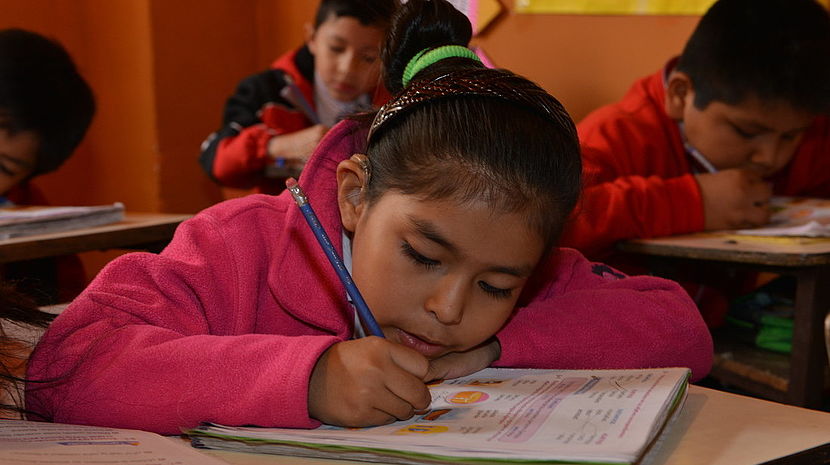05.11.2016 Hurricane Matthew – Green shoots of recovery

Three days. That’s how long it took. Three days to fully recover – both physically and emotionally – from what I experienced during my trip to Haiti’s southwestern peninsula, just two weeks after Hurricane Matthew made landfall. I had the honour of accompanying a team from CBM’s Haiti office that went to assess how people with disabilities dealt with the hurricane and determine what were their needs and priorities. As a communications professional, I went along with a photographer to capture and tell their stories.
The category-four hurricane hit the already vulnerable island nation on October 4, 2016, leaving in its wake a trail of devastation not seen in Haiti since the 2010 earthquake. Videos and pictures started circulating on social media almost immediately, showing the sheer power of Mother Nature. Powerful winds mowed down trees, ripped off roofs and lifted entire homes from their foundations. Rivers swelled, swallowing anything and everything in their paths…homes, roads, bridges, trees, livestock, residents.Survivors are left in need of rebuildingtheir lives, from fixing their homes to assuring they have enough food to eat tofinding ways to make a living to take care of their families.
Although I was nervous in the days leading up to the trip, as I didn’t know what we would see or how I would process the stories we’d hear, stories I knew would be heart-breaking, I couldn’t wait to go. So, I prepared as much as I could and at 6:30 a.m. on Sunday, October 16th, I waited to be picked up to start the estimated seven-hour journey. All along the road, as we got closer to the impacted area, I started looking for signs of destruction. And literally, just like that, about 3.5 hours in, we saw the first set of downed trees and damaged houses – those either missing roofs or completely flattened. But even with all of the pictures and videos we saw, nothing could have prepared us for what awaited us.
As we left the town of Les Cayes and got close to entering the city of Jérémie, our final destination for the day, we were left speechless. Complete devastation. Town after town, it was the same story, damaged trees, buildings and lives.
During our week-long trip, which had to be cut short due to extreme flooding from days of non-stop torrential downpours,we participated in coordination meetings at the Departmental Emergency Operation Centres (COUD), with the Coordinators of the Civil Protection Department (DPC) and the President’s Departmental Representative of the Grand Anse and South departments. During these meetings, we discussed the immediate need for food, water, medicine, corrugated metal and tarp to assist residents in the outskirts now, with long-term needs for economic opportunities, especially for people with disabilities. The most shocking outcome of that meeting was learning that there are areas that have no houses standing and that residents in those have taken to sleeping in graves and caves.
We also met with several Disabled Persons Organisations (DPOs) across the area, traveling at times up to three hours each way to assess their capacities to support their members, and had the opportunity to hear the heart-breaking stories from the members themselves. We also witnessed aid starting to reach some of the affected communities, although not specifically people with disabilities. But with so many hard-to-access villages, it may be weeks before some of these victims see anyone. Nonetheless, we were extremely happy to see several organisations and missionaries on the ground, mobilising to distribute food, provide medical attention and medicine to the sick and injured, as well as home improvement materials for those affected to start boarding up their houses.
Is it enough? Absolutely not! The need down there is enormous and people’s lives are at stake.
Most impressive though? The amount of local Haitians we saw working with these organizations. Again, is it enough? Far from it, but we started and that’s what’s most important! Now to keep it going, especially for those who were most affected.
I’m happy to have been involved in this early work. And I look forward to seeing how CBM, with its partners, ensures that people with disabilities, their families, and other community members are identified and supported to recover from the hurricane.
Finally, again on the bright side, as we left the greater south, we literally saw the shoots of recovery: We noticed that many of the trees that were brown and completely bare from losing their leaves on Sunday when we first got there, have already starting sprouting bright green new baby leaves.
Just a little reminder that there is always hope as long as there is life!
More reading:
Leanie, who works with a local Disabled Person’s Organisation (DPO) in Haiti, lost her house and livelihood during hurricane Matthew. She is matter-of-fact about the situation, saying “I just want to go back to being able to take care of myself”. Read her story here.